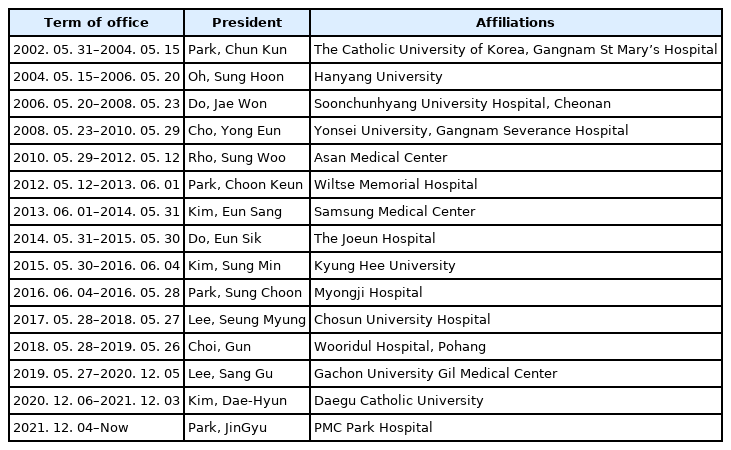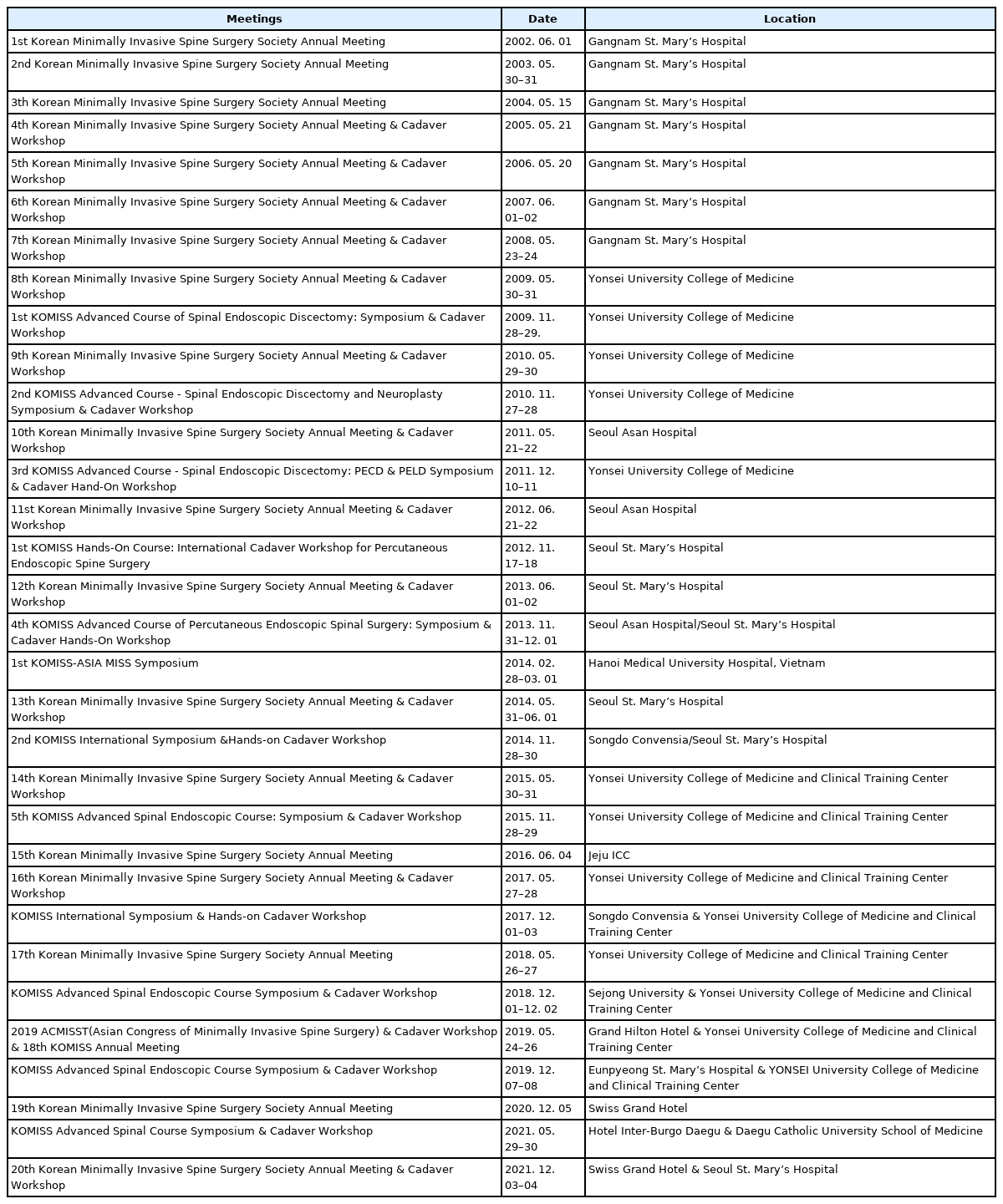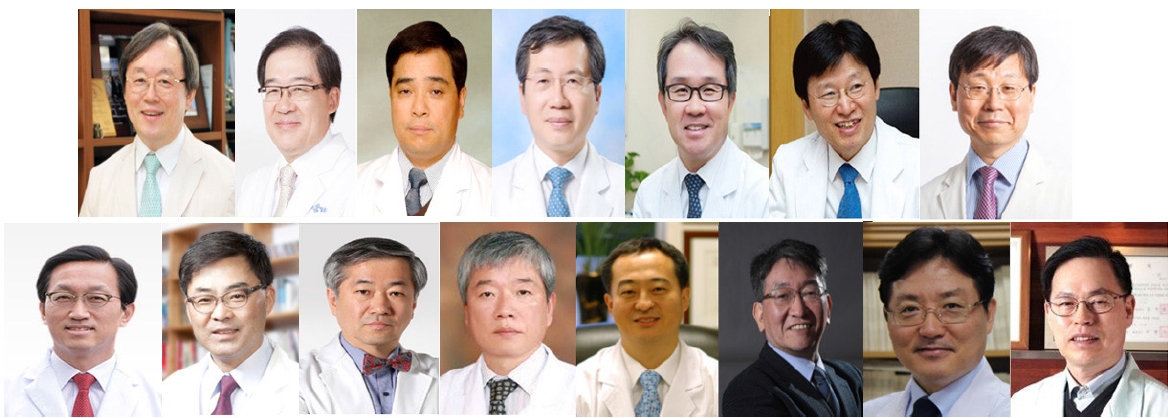The History of Korean Minimally Invasive Spine Surgery Society (KOMISS) and Global Impact on Spine Surgery
Article information
Abstract
Korea minimally invasive spine surgery society (KOMISS) celebrated its 20th anniversary this year in 2021. The society was established in 2002 for the purpose of research on novel techniques and instruments in the rapidly developing field of spine surgery, under the leadership of Professor Park, Chun Kun, the first president. Annual meetings have been held every year since. The advanced course focusing on endoscopic surgery was introduced in 2009, while international academic conferences and cadaver workshops have been held since 2012. In 2012, the first textbook was published. In 2015, KOMISS was promoted to an official society by integrating with the Korean Society for Minimally Invasive Spine Surgery, another Korean society for minimally invasive spine surgery (MIS). Additionally, in 2017, the Korean Research Society of Endoscopic Spine Surgery (KOSESS), a research group specialized in spinal endoscopic surgery, was established as its own society. Presently, in the face of the ongoing corona pandemic, there is continuous research efforts through online meetings. For the past 20 years, KOMISS has been educating Korean doctors on MIS surgery through various symposiums and hand on workshops, and has gradually established its ranks and expanded its scope around the world. Most importantly, among the many areas of minimally invasive spinal surgery, KOMISS has developed surgical techniques focusing on endoscopic spinal surgery above all else and has had an unrivaled impact worldwide. Consequently, pioneers and world-renowned surgeons of endoscopic spine surgery in KOMISS have inaugurated the era of endoscopic spine surgery as gold standard of care.
THE HISTORY OF KOREAN MINIMALLY INVASIVE SPINE SURGERY SOCIETY (KOMISS, FOUNDING PROCESS, AND CURRENT STATUS)
Since the 1980s, as the use of a surgical microscope became common, interest in minimally invasive surgical treatment has increased in the field of spinal surgery. Various spinal surgical methods and new micro-instruments have been rapidly developed, changing the general perception of surgery for various spinal diseases. Following this trend, the executive board of directors of the Korean Spinal Neurosurgery Society (KSNS) decided to establish a minimally invasive spinal surgery research group under their society. Korean Minimally Invasive Spine Surgery Society (KOMISS) was established in 2002 by Professor Chun Kun Park, of the Catholic University of Korea, to promote academic development and academic exchanges on clinical and basic research in the field of minimally invasive spine surgery (Figure 1).
The first president, Park Chun-Kun, advocated that even spine specialists find it challenging to understand newly developed instruments and acquire surgical techniques due to the rapid changes in the field of spinal surgery. Furthermore, he emphasized that the society should research and verify whether the newly developed techniques would actually help patients in the clinical field. In addition to these efforts, Korean neurosurgeons are actively participating in the forefront of spinal surgery, making them global leaders in the field of minimally invasive spine surgery. For that reason, he promoted the necessity of establishing a surgical research group. On June 1, 2002, the first annual meeting of the KOMISS was held in the auditorium on the 2nd floor of the main building of Gangnam St. Mary’s Hospital (now Seoul St. Mary’s Hospital), The Catholic University of Korea. This first meeting marks the historical beginning of the KOMISS (Figure 2).

(A) The first symposium and hands-on workshop of Korean Minimal Invasive Spine Surgery Research Society. (B) Newspaper script announcing the founding of KOMISS.
Since then, regular academic conferences and general meetings have been held every year. Since 2009, the KOMISS Advanced Course has been additionally held in the fall to keep pace with the rapidly increasing demand for education on minimally invasive surgery.
As Korea’s minimally invasive spine surgery technology has been recognized worldwide, the need for an international conference has emerged. Consequenty, the International Symposium and Cadaver Workshop has been held every other year since its introduction in 2012.
In that same year, along with the academic conference, the principle of minimally invasive spine surgery was established. The textbook “Minimally Invasive Spine Surgery,” a textbook covering the latest surgical methods, was published, contributing to publicizing the status of minimally invasive spine surgery in Korea. Since 2012 [1], there has been a publishing boom from textbooks published by the editor-in-chief and the board of directors of KOMISS. Presented sequentially, the following are a highlight of these published works: the first English publication of Endoscopic Spine Procedures (SH Lee, Gun Choi, publisher Thieme) [2], Endoscopic Spinal Surgery (SH Lee, JP, 2013) [3], Endoscopic Spine Surgery 2nd edition (SH Lee, Gun Choi, Thieme, 2018) [4], Endoscopic Procedures on the Spine (JS Kim, JH Lee, and Y Ahn, Springer, 2019) [5], and Unilateral Biportal Endoscopic Spine Surgery (DH Heo, CW Park, SK Son, and JH Eum, Springer, 2022) [6].
In 2020, an updated textbook with the latest knowledge and techniques for endoscopic surgery of the lumbar spine was published, which was led by KOMISS and KOSESS members (Figure 3) [7].
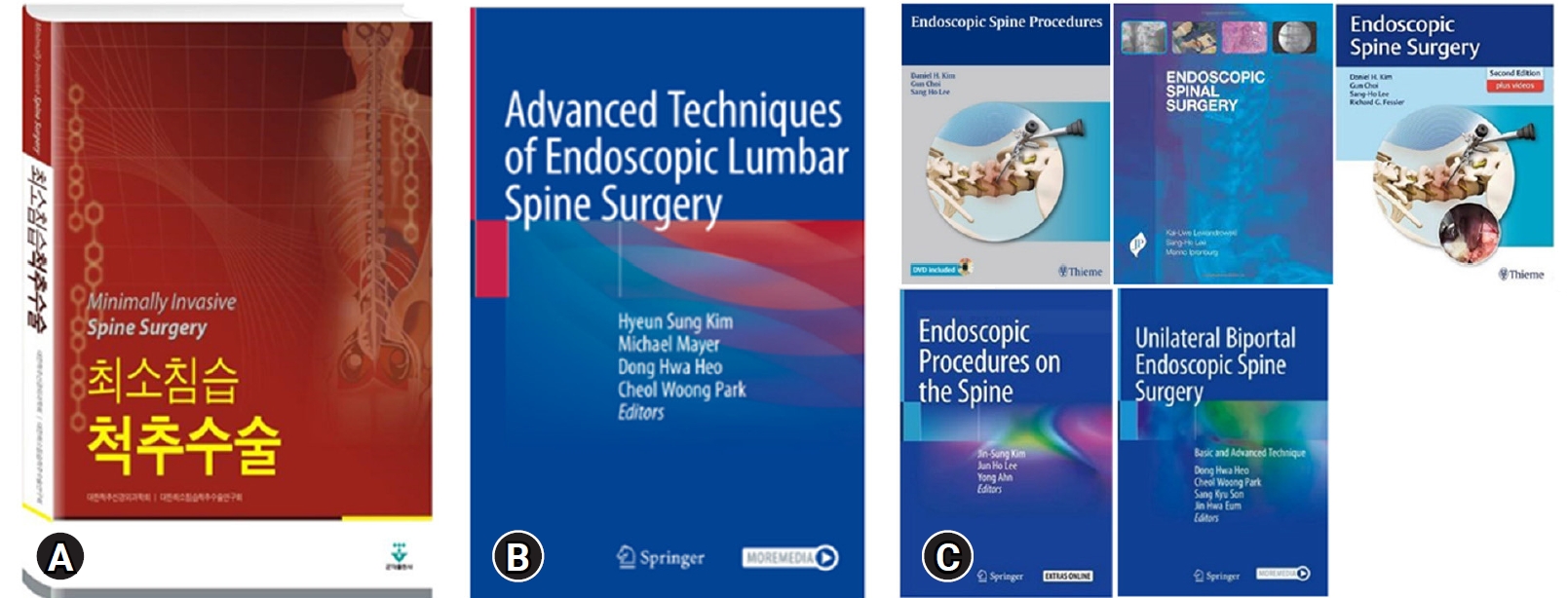
(A) The textbook “Minimally Invasive Spine Surgery” [1]. (B) Advanced Techniques of Endoscopic Lumbar Spine Surgery (2020). (C) Endoscopic Spine Procedures (SH Lee, Gun Choi; publisher Thieme) [2]. Endoscopic Spinal Surgery (SH Lee, JP, 2013) [3]. Endoscopic Spine Surgery 2nd edition (SH Lee, Gun Choi, Thieme, 2018) [4]. Endoscopic Procedures on the Spine (JS Kim, JH Lee, and Y Ahn, Springer, 2019) [5], and Unilateral Biportal Endoscopic Spine Surgery (DH Heo, CW Park, SK Son, and JH Eum, Springer, 2022) [6] (sequentially from left to right).
In 2014, along with the 2nd international symposium, the Korean homepage, which was only open to domestic members, was significantly revised. In addition, an English homepage (www.komiss.org) was established, bridging a way to communicate with spine doctors across the globe (Figure 4).
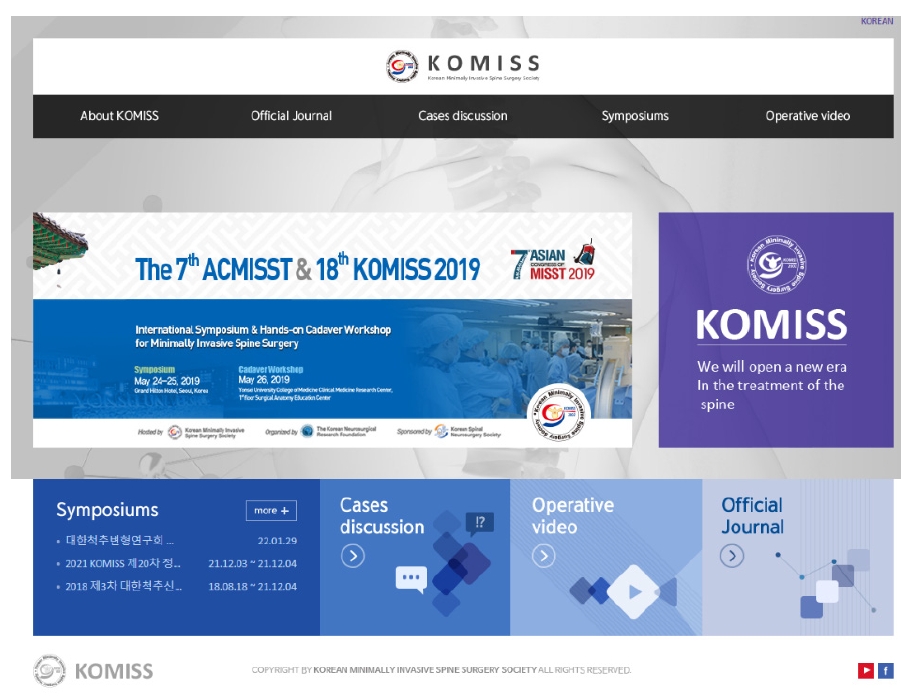
English homepage (www.komiss.org)
In 2015, KOMISS was officially approved as a regular society of Korea. Incorporated with the Society of Surgery (International Society for Minimal Intervention in Spinal Surgery, ISMISS Korea, President Chun-Kee Chung), it has established itself as a representative society for minimally invasive spine surgery in Korea in name and reality. KOSMISS, The Korean Chapter of ISMISS was driven by Sang-Ho Lee, the founder of Wooridul Spine Hospital, and was founded in 1997 under the leadership of professor Hwan-Young Jung. The academic annual meeting was held every year for 18 years until 2015. Hwan Yung Chung (1997–2001), Hyun Jip Kim (2002–2009), and Professor Chun-Kee Chung (2010–2015) contributed as past presidents (Figure 5).
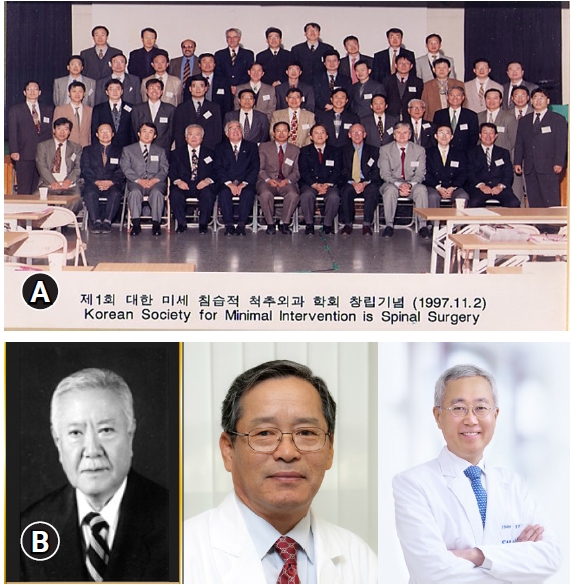
(A) A photograph of the founding International Society for Minimal Intervention in Spinal Surgery (ISMISS). (B) Hwan Yung Chung (1997–2001), Hyun Jip Kim (2002–2009), and professor Chun-Kee Chung (2010–2015), the past presidents of ISMISS (sequentially from left to right).
The first issue of the Journal of Minimal Invasive Spine Surgery & Technique (JMISTT), an official academic journal of the society, was published along with the 2016 international academic conference, which was held in Jeju at the World Congress of Minimally Invasive Spine Surgery & Techniques (WCMISST). In addition, JMISST has been the co-official journal of the KOMISS and Minimally Invasive Spine Surgeons Association of Bharat (MISSAB) for the publication of research results about minimally invasive spinal surgery from Vol 6, No. 1 published on April 2021 (Figure 6).
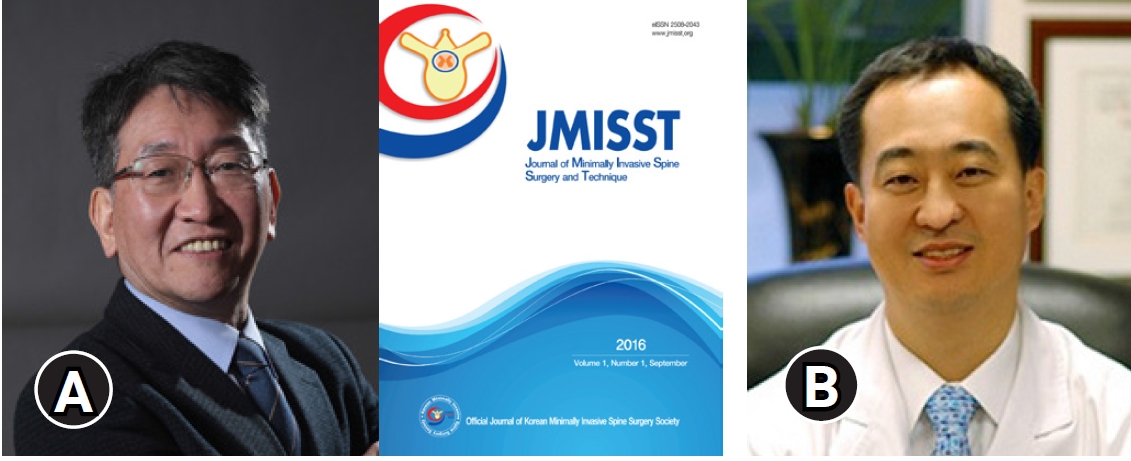
(A) The first editor-in-chief, Lee, Sang Gu of the Journal of Minimal Invasive Spine Surgery & Technique (JMISTT) and the first publication. (B) Gun Choi, the first president of the Korea Research Society of Endoscopic Spine Surgery (KOSESS).
In 2017, the Korea Research Society of Endoscopic Spine Surgery (KOSESS), which specializes in spine endoscopic surgery only, was launched as an affiliated organization, with Gun Choi as the first president (Figure 7). In the same year, KOREA UBE (unilateral bi-portal endoscopy), which specializes in bi-directional spinal endoscopic surgery, was also launched having Sang-Kyu Son as its first president.
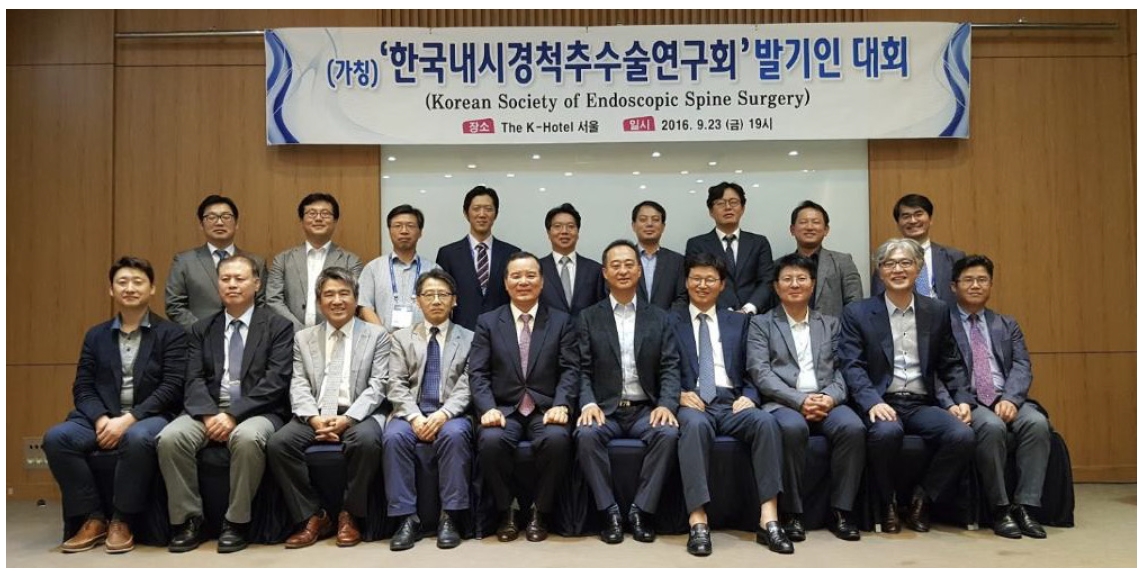
The Korea Research Society of Endoscopic Spine Surgery (KOSESS), which specializes in endoscopic spine surgery.
2022 is the 20th anniversary of KOMISS. In the present corona pandemic era, it has grown into a society that strives to fulfill its mission of minimal invasiveness to patients and to enhance recovery after spine surgery (ERAS) (Table 1, 2, Figure 8).
ACADEMIC ACTIVITIES AND GLOBAL IMPACT OF KOMISS
Starting with the first academic conference on June 1, 2002 and up until 2021, the KOMISS has held a total of 19 regular academic conferences, 9 Advanced Endoscopic Courses, three international symposiums, and 19 Cadaver Workshops. In addition, since 2015, case meetings have been held twice a year.
At the first regular academic conference, starting with percutaneous vertebral body balloon angioplasty, artificial disc insertion, and spinal fixation using thoracoscopic techniques, the newly introduced spinal surgery instruments around the world were presented annualy. Additionally, overseas speakers and domestic experts well-known for their surgical techniques utilizing these novel instruments were also invited to present. Through cadaver workshops, students learn how to use new instrumentation and surgical techniques in practice, translated from theory to clinical application.
Starting with the 1st KOMISS Advanced Endoscopy Course on November 28, 2009, every fall an in-depth symposium and Cadaver Workshop covering various endoscopic surgical methods is held to perform domestic spinal endoscopic surgery [8].
In addition, as Korea’s minimally invasive spinal surgery technology has been recognized worldwide, the need for an international conference has emerged. From the 1st International Symposium and Cadaver Workshop held on November 17, 2012, a conglomerate effort has been made in the creation of a learning space for the dissemination of shared knowledge by inviting people from all over the world to spread Korea’s advanced minimally invasive techniques to participants overseas [9].
Recently, on June 4, 2016, the 15th regular academic conference of KOMISS was jointly held in Jeju with the WCMISST, a global international society of minimally invasive spine surgery. Moreover, it also hosted a meaningful event with 470 people from 35 participating countries. In 2018, Jin-Sung Kim (vice president of KOMISS) joined the AOSpine MIS Task Force and created an educational curriculum for endoscopic spine surgery. Furthermore, the executive members of KOMISS have been actively engaged in the main stream societies such as Global Spine Congress (GSC) and the North American Spine Society (NASS). As the course chair, Jin-Sung Kim organized the first endoscopic course in the annual meetings of both NASS and GSC with the collaboration of Jun-Ho Lee. AOSpine Davos course, one of the flagship educational events, was also chaired by JS Kim in 2018. Withal, the NASS/Neurospine Endoscopic Spinal Surgery (ESS) Symposium and Cadaver Workshop were both held at NASS in 2018 and 2019 through KOMISS collaboration. In the consecutive years prior to the pandemic, the endoscopic courses were chaired by renowned executive members of KOMISS: JS Kim and HS Kim in 2018 and 2019 respectively (Figure 9).
Based on the recent bibliometric study, KOREA published the second (28.68%) highest number of endoscopic spine surgery related papers after China (30.15%) among 408 total papers published worldwide from 1997 to 2018, while the index was highest in Korea (23) Also, as a single institution, Wooridul Spine Hospital in Korea (10.29%) published the largest number of papers [10]. Since endoscopic surgery started in the early 1990s, there have been many papers and achievements authored by Korean society members that have been milestones in the development of surgerical techniques since 2000, notably mentioned are Sang-Ho Lee, Gun Choi, Yong Ahn, Jin-Sung Kim, Hyeun-Sung Kim, Jin-Hwa Eum, Sang-Kyu Son, and Dong-Hwa Heo (Figure 10) [11].
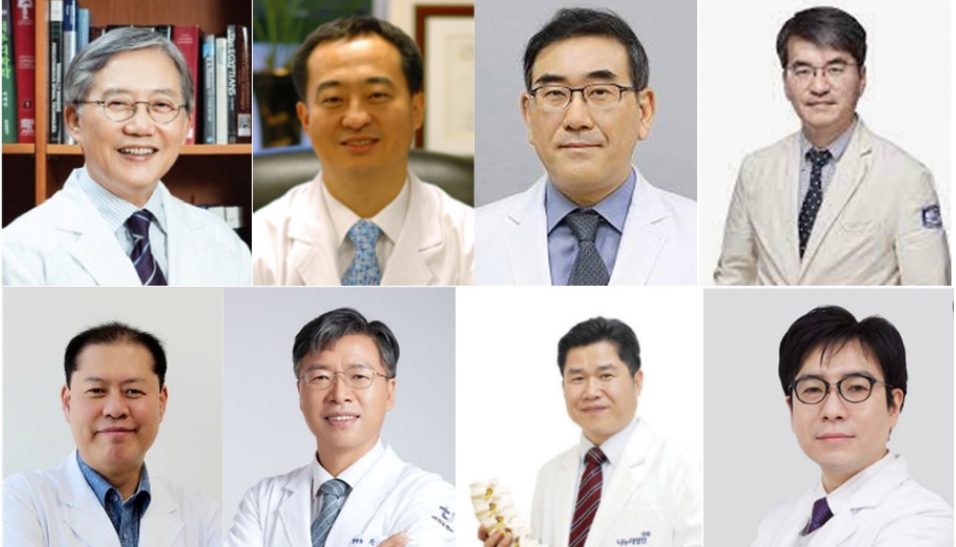
Sang Ho Lee, Gun Choi, Yong Ahn, Jin-Sung Kim, HS, Jin-hwa Eum, Sang-Kyu Son, and Dong-Hwa Heo made contributions for the development of endoscopic spine surgery. (sequentially from left).
While the coronavirus pandemic hit the world in 2020, KOMISS continued research and educational opportunities through online broadcasts.
The Korean Society of Minimally Invasive Spine Society has a long history and tradition. It is a progressive and pioneering society that carries out original and substantial academic research by constantly introducing new spinal surgery instruments and techniques without relying on past achievements.
Notes
No potential conflict of interest relevant to this article.
Acknowledgements
English proofreading of this paper was performed by Dr. Claudia Covarrubias.

